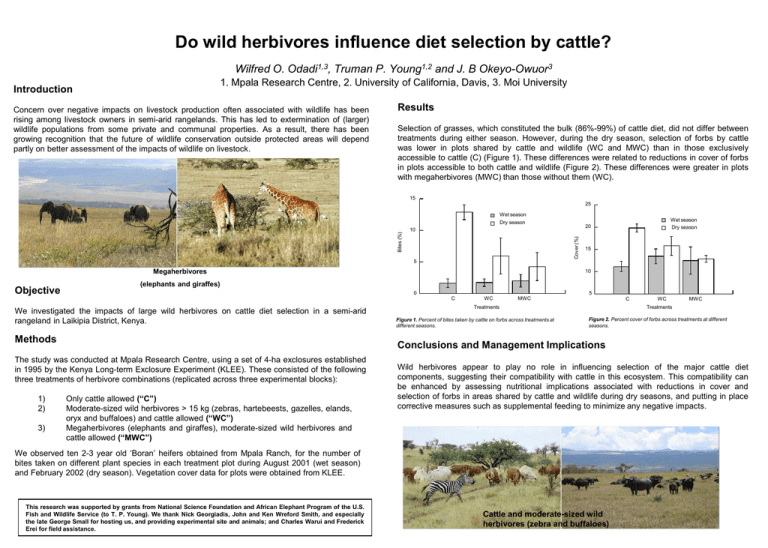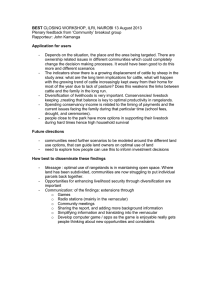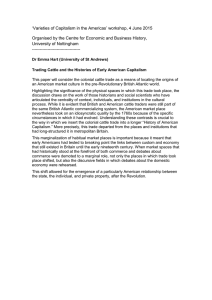Odadi
advertisement

Do wild herbivores influence diet selection by cattle? Wilfred O. Odadi1,3, Truman P. Young1,2 and J. B Okeyo-Owuor3 1. Mpala Research Centre, 2. University of California, Davis, 3. Moi University Introduction Concern over negative impacts on livestock production often associated with wildlife has been rising among livestock owners in semi-arid rangelands. This has led to extermination of (larger) wildlife populations from some private and communal properties. As a result, there has been growing recognition that the future of wildlife conservation outside protected areas will depend partly on better assessment of the impacts of wildlife on livestock. Results Selection of grasses, which constituted the bulk (86%-99%) of cattle diet, did not differ between treatments during either season. However, during the dry season, selection of forbs by cattle was lower in plots shared by cattle and wildlife (WC and MWC) than in those exclusively accessible to cattle (C) (Figure 1). These differences were related to reductions in cover of forbs in plots accessible to both cattle and wildlife (Figure 2). These differences were greater in plots with megaherbivores (MWC) than those without them (WC). 15 25 Wet season 5 Megaherbivores Objective 10 0 We investigated the impacts of large wild herbivores on cattle diet selection in a semi-arid rangeland in Laikipia District, Kenya. Methods 5 WC MWC C Treatments Figure 1. Percent of bites taken by cattle on forbs across treatments at different seasons. WC MWC Treatments Figure 2. Percent cover of forbs across treatments at different seasons. Conclusions and Management Implications The study was conducted at Mpala Research Centre, using a set of 4-ha exclosures established in 1995 by the Kenya Long-term Exclosure Experiment (KLEE). These consisted of the following three treatments of herbivore combinations (replicated across three experimental blocks): 3) 15 (elephants and giraffes) C 1) 2) Wet season Dry season 20 Cover (%) Bites (%) Dry season 10 Only cattle allowed (“C”) Moderate-sized wild herbivores > 15 kg (zebras, hartebeests, gazelles, elands, oryx and buffaloes) and cattle allowed (“WC”) Megaherbivores (elephants and giraffes), moderate-sized wild herbivores and cattle allowed (“MWC”) Wild herbivores appear to play no role in influencing selection of the major cattle diet components, suggesting their compatibility with cattle in this ecosystem. This compatibility can be enhanced by assessing nutritional implications associated with reductions in cover and selection of forbs in areas shared by cattle and wildlife during dry seasons, and putting in place corrective measures such as supplemental feeding to minimize any negative impacts. We observed ten 2-3 year old ‘Boran’ heifers obtained from Mpala Ranch, for the number of bites taken on different plant species in each treatment plot during August 2001 (wet season) and February 2002 (dry season). Vegetation cover data for plots were obtained from KLEE. This research was supported by grants from National Science Foundation and African Elephant Program of the U.S. Fish and Wildlife Service (to T. P. Young). We thank Nick Georgiadis, John and Ken Wreford Smith, and especially the late George Small for hosting us, and providing experimental site and animals; and Charles Warui and Frederick Erei for field assistance. Cattle and moderate-sized wild herbivores (zebra and buffaloes)






